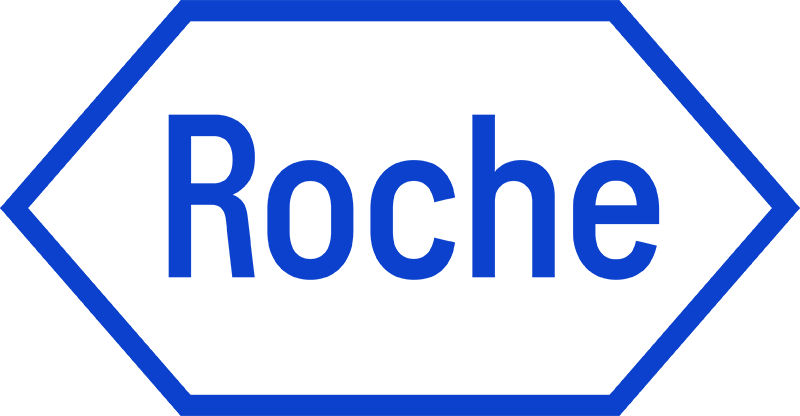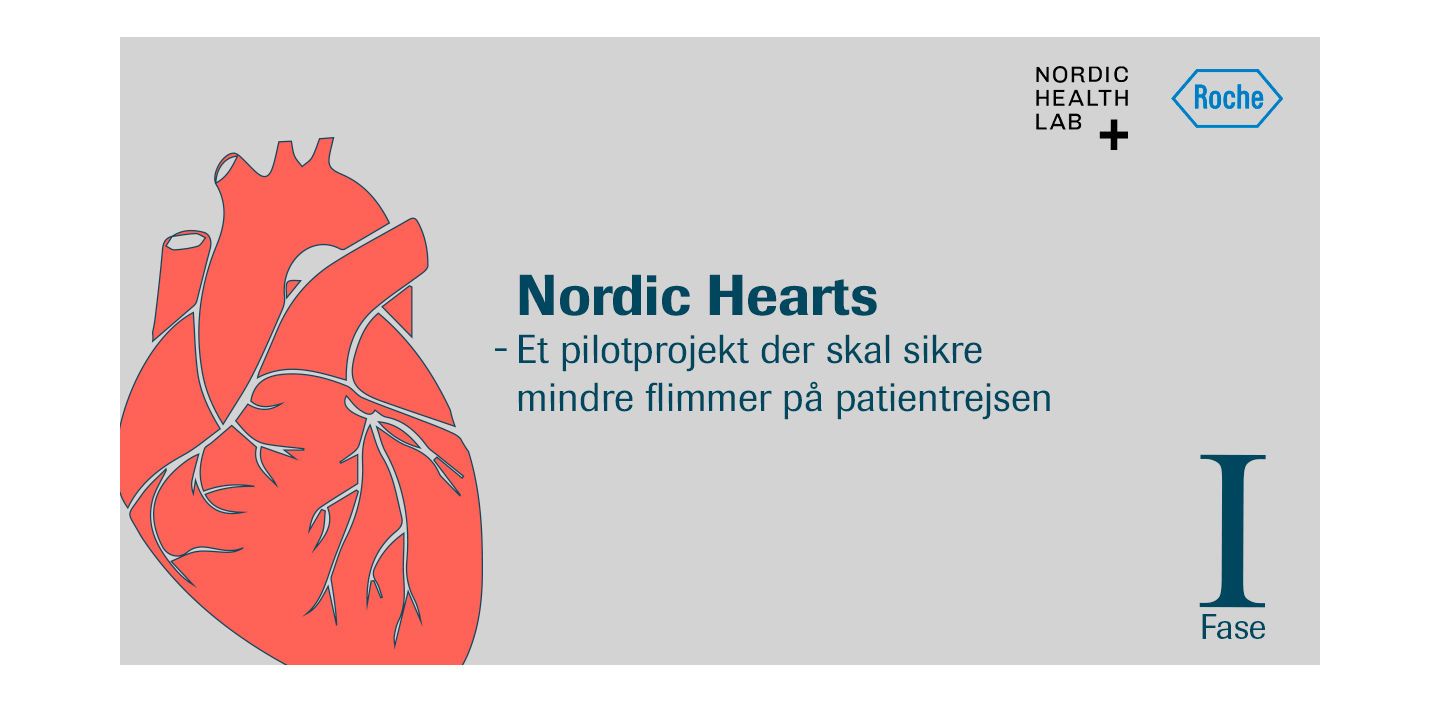Hjerteflimmer kan nu overvåges fra eget hjem af egen læge
I et internationalt samarbejde har Roche Diagnostics og Nordic Health Lab testet to nye løsninger, der kan monitorere og opspore hjerteflimmer hos praktiserende læger. Projektet Nordic Hearts 1 er sat i verden for at skabe bedre og mere præcise patientforløb for hjertepatienter.
Har du nogensinde stået med følelsen af åndenød, svimmelhed eller hjertebanken?
Det er alt sammen symptomer på hjerteflimmer. Hjerteflimmer er i dag et folkesundhedsproblem med over 33,5 millioner patienter på verdensplan. I gennemsnit tager det 1,7 år at diagnosticere, og omkring 40% af dem, der lider af hjerteflimmer, er udiagnosticerede. Samtidig øger hjerteflimmer risikoen for at få en blodprop med op til fem gange.
Hjerteflimmer er svært og tidskrævende at opdage
Svage symptomer kombineret med begrænsede værktøjer til at registrere hjerteflimmer gør hele den diagnostiske proces vanskelig.
Hvis man oplever uregelmæssigheder i forbindelse med sit hjerte er første skridt typisk en konsultation hos egen læge. Når egen læge tjekker for hjerteflimmer, kræver det i dag, at der måles på det eksakte tidspunkt, hvor patienten oplever hjerteflimmer. Praktiserende læger kan gøre brug af et elektrokardiogram (EKG), hvilket giver præcise målinger, men som kun måler i få minutter.
Den korte monitoreringsperiode betyder, at der ofte ikke bliver registreret hjerteflimmer, men at patienten alligevel typisk vil blive videresendt til udredning på hospitalet. En stor andel af alle patienter, der henvises til hjerteafdeling med mistanke om hjerteflimmer, viser sig ikke at have lidelsen, hvilket medfører en unødvendig arbejdsbyrde for hospitalets personale.
Roche Diagnostics har et ønske om at opspore patienter med hjerteflimmer tidligere således, at tiden til diagnose afkortes, samt at hjælpe de praktiserende læger med at henvise de rigtige patienter til hjerteafdelingerne.
Digitale løsninger til monitorering af hjerteflimmer
To mulige løsninger, der begge kan måle hjerterytmeforstyrrelse uanset, hvor brugeren fysisk opholder sig, er blevet testet hos fire praktiserende læger i Nordsjælland i samarbejde med Hjerteafdelingen på Nordsjællands Hospital. Pilotprojektet blev udført over ni uger, og i alt har 25 brugere deltaget i forsøget.
De testede løsninger er henholdsvis det elektroniske plaster SmartCardia og smartphone-applikationen FibriCheck. Fælles for begge løsninger er, at de er så enkle, at de kan udleveres af de praktiserende læger og anvendes af patienten selv.
SmartCardia-plasteret tager kontinuerligt EKG-målinger. Det er på størrelse med en tændstikæske, og man har det siddende på brystkassen i syv dage.
FibriCheck foretager spotmålinger, når brugeren åbner appen og aktiverer kamerasensoren på sin mobiltelefon med et tryk eller en berøring. I testperioden på 30 dage målte brugerne som minimum to gange dagligt og, hvis vedkommende oplevede symptomer.
En sammenhængende patientrejse
Forløbet er netop afsluttet, og resultaterne er lovende. Løsningerne har potentialet til at ændre patientforløbet radikalt.
”Brugerne fandt løsningerne intuitive og nemme at anvende. Flere af brugerne så stor værdi i at kunne blive undersøgt hos deres egen læge, i stedet for at blive henvist til hospitalet. Derudover følte brugerne sig mere involveret i deres udredningsforløb, i det de eksempelvis selv skulle foretage målinger ved hjælp af appen,” fortæller Sofie Phillipsen, projektleder fra Nordic Health Lab.
Og det er ikke kun for patienterne, de digitale løsninger skaber værdi. Også hospitalspersonale og praktiserende læger er begejstrede.
”De praktiserende læger mener, at denne tidlige opsporing er et effektivt værktøj til at udføre hurtige udredninger,” fortæller Sofie Phillipsen. Løsningerne skal dog undersøges yderligere, før man ændrer på praksis.
Niels Tønder, ledende overlæge på Hjerteafdelingen, Nordsjællands Hospital, har bidraget med ekspertviden om hjertepatienter, og han er enig i, at værktøjerne kan gøre en stor forskel:
”Vi ser, at det kan give værdi at sætte større fokus på monitorering af hjertesymptomer ude hos de praktiserende læger. Kan der ske en bedre selektion ude hos de praktiserende læger, kan det både sikre bedre patientbehandling og spare en masse ressourcer.”
Det videre forløb
”Disse løsninger kan i realiteten medvirke til at ændre praksis for, hvordan man opsporer hjerteflimmer både hos praktiserende læge og på hospitalet. Vi er ved at undersøge, hvordan en mulig eskalering af projektet bør se ud,” fortæller Jane Hilligsøe, Healthcare Development Partner hos Roche Diagnostics.
Projektet har allerede nu affødt et nyt udviklingsforløb, Nordic Hearts 2, som skal teste løsningerne i et større setup.
Roche Diagnostics A/S leverer diagnostiske løsninger til hele det danske sundhedsvæsen. Fibricheck og Smartcardia indgår begge i Roche’s internationale startup-program, Startup Creasphere, som er et udviklingsmiljø til startups, hvis videreudvikling Roche Diagnostics gerne vil støtte.
Atrial fibrillation can now be monitored at home by your own GP
In an international collaboration, Roche Diagnostics and Nordic Health Lab have tested two new solutions for monitoring and detecting atrial fibrillation at General Practitioners. The project Nordic Hearts 1 was launched to facilitate better and more accurate patient flows for cardiac patients.
Have you ever experienced shortness of breath, dizziness or palpitations?
These are all symptoms of atrial fibrillation. Today, atrial fibrillation is a public health problem with more than 33.5 million patients globally. On average, it takes 1.7 years to diagnose the condition and approximately 40 % of all people suffering from atrial fibrillation are undiagnosed. Furthermore, atrial fibrillation increases the risk of having a heart attack with up to five times.
Atrial fibrillation is difficult and time-consuming to detect
Vague symptoms combined with limited methods of detecting atrial fibrillation complicate the diagnostic process.
If you experience cardiac irregularities, you would typically consult your GP as a first step. When a GP checks for atrial fibrillation today, he or she will only detect it, if it coincides precisely with the time of measurement. A GP will use electrocardiography (ECG), which provides a very precise method of measurement, but only for a few minutes.
Such a short period of monitoring means that atrial fibrillation will typically not be detected, but the patient will nevertheless often be referred to a hospital for further examinations. A large portion of all patients referred to the cardiac department on suspicion of atrial fibrillation turn out not to suffer from this condition, causing an extra workload for the hospital staff.
Roche Diagnostics would like to identify patients with atrial fibrillation earlier to help reduce diagnostic time and assist GPs in referring the right patients to the cardiac departments.
Digital solutions for monitoring atrial fibrillation
Two potential solutions – both capable of measuring heart rhythm disorders regardless of the user’s whereabouts – have been tested by four GPs in the north of Zealand, Denmark, in collaboration with the cardiac department at Nordsjællands Hospital. The pilot was conducted over a course of nine weeks, and a total of 25 users participated in the project.
The solutions tested were the electronic patch SmartCardia and the smartphone application FibriCheck. The two solutions are both so easy to use that the GPs can hand them over to the patients for them to use by themselves.
The SmartCardia patch is continuously monitoring the ECG of the patient. It’s the size of a matchbox and it remains attached to the chest of the patient for seven days.
FibriCheck performs spot measurements when the user opens the app and activates the camera sensor on his or her mobile phone with a push or a touch. During the 30-day test period, the users performed at least two daily measurements, or performed a measurement if they experienced symptoms.
A coherent patient journey
The test has recently ended, and the preliminary results look promising. The solutions have the potential to transform the patient flow drastically.
”The users described the solutions as intuitive and user-friendly. Several users were very pleased that they could be examined by their regular GP, instead of having to go to a hospital. And furthermore, the users felt more involved in their examination process, because they themselves had to perform the measurements using the app,” says Sofie Phillipsen, project manager at Nordic Health Lab.
And it’s not just the patients that benefit from the value created by these digital solutions. Hospital staff and GPs are equally enthused.
”GPs feel that this early detection tool could be an effective means for achieving faster diagnoses,” explains Sofie Phillipsen. However, further study of the solutions is required, before the current practice is changed.
Niels Tønder, Head of Cardiology at Nordsjællands Hospital, has contributed to the project with specialist knowledge about cardiac patients, and he agrees that these tools could have a big impact.
”We can see that it actually matters to put greater focus on monitoring cardiac symptoms at the GPs. If we achieve a better patient selection at the GPs, both we and the patients could save a lot of time,” he explains.
What happens next
”These solutions can actually play a part in changing how we detect atrial fibrillation at the GPs and the hospitals. We are looking into what a potential upscaling of the project should look like,” says Jane Hilligsøe, Healthcare Development Partner at Roche Diagnostics.
The project has already prompted a new development process, Nordic Hearts 2, where the solutions will be tested on a larger scale.
Roche Diagnostics A/S provides diagnostic solutions to the entire Danish healthcare system. FibriCheck and SmartCardia are both part of Roche’s international start-up program, Startup Creasphere, a development ecosystem for start-ups, whose development Roche Diagnostics would like to support.

